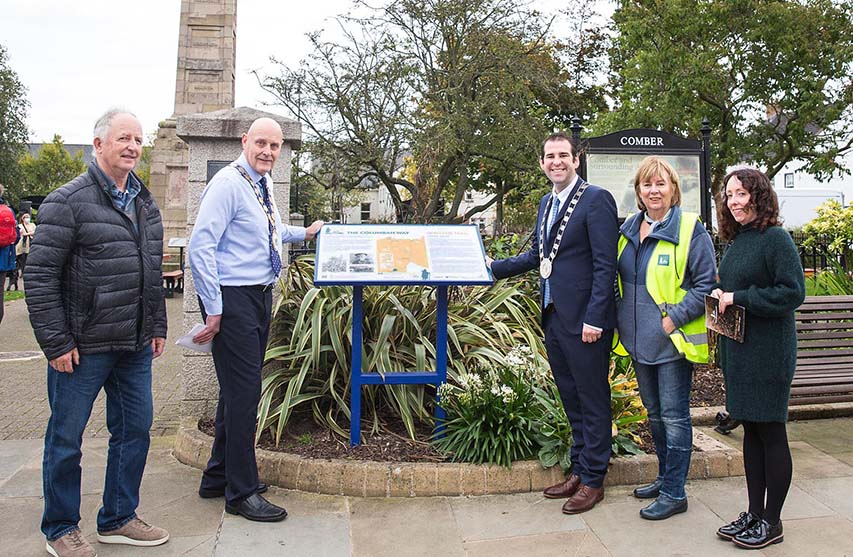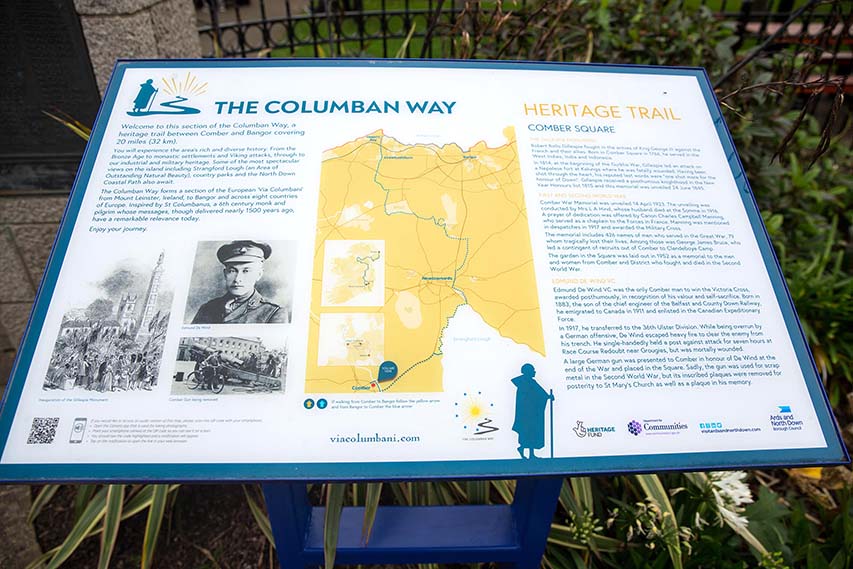Celebrate North Down Heritage On The Columban Way Trail
A 20-mile section of the Columban Way Heritage Trail was launched in Comber on Saturday (23 October).
Funded by the National Lottery Heritage Fund, the trail stretches from Comber to Bangor and is the first section of The Columban Way to be officially launched in Northern Ireland.
The Columban Way forms part of the wider European ‘Via Columbani’ heritage trail. It traces the route from Mount Leinster to Bangor and across eight countries of Europe, finishing in Bobbio, Italy.
The launch of the first section in Ireland will take place in County Carlow later this month. The ambition is to link both sections throughout the island to create an impressive cross-border, long-distance walking trail.
The Mayor of Ards and North Down, Councillor Mark Brooks, said: “Ards and North Down’s heritage is one that should be embraced by everyone. This 20-mile section of trail will encourage more people to learn about our history, including the impact the area had in a European context through the links with Columbanus.

“There are some spectacular views along the route too and I would encourage everyone to take some time out and visit the various points of interest along this section of the Columban Way.”
Paul Mullan, Director of the National Lottery Heritage Fund in Northern Ireland, said: “We are delighted to support this project through the Community Heritage Fund. Our local places have become more important than ever throughout the pandemic, and through this fund, we hope to encourage people to get to know their local heritage that bit better.
“We are grateful to the Department for Communities for providing the funding and we are delighted to fund a diverse range of projects which will make a huge impact on many communities across Northern Ireland.”
As part of the project, waymarkers and interpretational panels have been installed along the route. They are combined with online resources such as audio content and online mapping as well as information detailing the many heritage sites along the route.

Those sites include the Somme Museum, Grey Point Fort, North Down Museum and Bangor Abbey. The route also takes in some of the area’s most stunning natural settings including Whitespots Country Park, Clandeboye Estate, and the North Down coast.
Similar trails within the Columban Way umbrella are currently being established across Europe. They trace the footsteps of St. Columbanus, who was originally from Leinster. Once completed and linked, this European trail has the potential to become the second longest pilgrimage route in Europe, after the Camino de Santiago.
Columban Way Trail Heritage Sites
Comber Town: Comber grew as a market town through the 19th and 20th centuries. Famous for being the birthplace of Thomas Andrews, the designer of the RMS Titanic, who died in the sinking of the Titanic in 1912. The town now holds an award-winning monthly Farmers’ Market by the town square at St Mary’s Church.
Somme Museum: At Whitespots Country Park, the Somme Museum examines Ireland’s role in the First World War. It provides a unique perspective with fascinating artefacts, exhibitions, and reconstructions of the battlefront at the Somme.
Lead Mines: Designated as an Area of Special Scientific Interest (ASSI), the area was mined for lead from 1776-1913.Reminders of this era can still be seen today in the form of a windmill stump, mine shafts and chimneys which are all still visible.
Clandeboye Estate/Helens Tower: The Tower, completed in 1861, was designed by William Burn in the Scottish Baronial style. Lord Dufferin named the tower after his mother Helen Selina Sheridan. Poems were written in its honour by 19th century luminaries including Tennyson and Kipling.
Clandeboye estate is the historic home of the Dufferin and Ava family and is now also famous for its delicious yoghurt made from the local herd.
Grey Point Fort: Completed in 1907, the fort was a key part of Belfast’s defences against naval attack, however it proved to be of limited value during the 1941 German air attacks. There are two small museums on site featuring interesting exhibits of military memorabilia and radio equipment.
Coastal Path: Stride out along one of the finest shoreline walks in Ireland. Part of the Columban Way,
stretching from Holywood, to the rocky outcrop of Orlock, Portavo. On a walk along the coastal path you can enjoy a variety of geological features, some 400 to 500 million years old making them among the oldest in Ireland, or identify the many different wildflowers and shrubs.
Bangor Abbey: St Comgall founded the Abbey in 558AD and it grew to become one of the most important seats of learning in Ireland, with almost 3,000 monks at the time of Comgall’s death in 601AD. The main body of the building dates from the 1830’s and 1840’s, the tower is from the 15th century and the octagonal steeple dates from around 1693.
North Down Museum: North Down Museum offers the chance to experience the area’s rich and diverse history, Bronze Age relics, monastic settlements, Viking attacks, industrial heritage and military influences in both the First and Second World Wars.
Columban Way: Born in Leinster in 543 AD, Columbanus and his disciples left Bangor in 591AD, to travel throughout Europe. According to Robert Schuman, one of the founding fathers of the European Union, he is “the patron saint of all those who now seek to build a better Europe”. The term ‘Europe’ was first used to refer to a geographical entity in his writings.
The Columban Way can become the second longest pilgrimage route in Europe, after the Camino de Santiago and involves the nations of Austria, France, Germany, Italy, Liechtenstein, Republic of Ireland, Switzerland and the UK. The Columban Way is a platform for cultural and scientific exchange, a tourism and economic development initiative and an ambitious plan to create a route that crosses Western Europe from north to south.
























